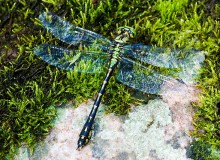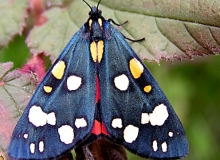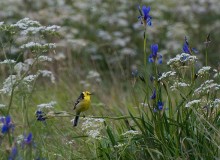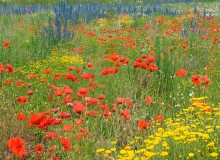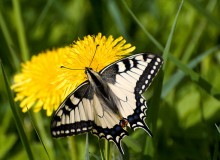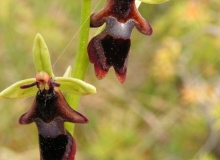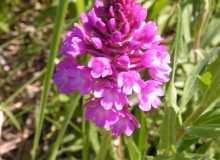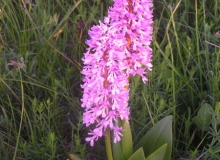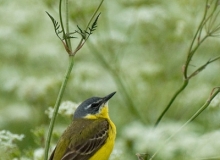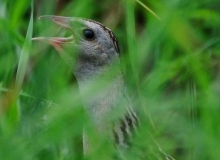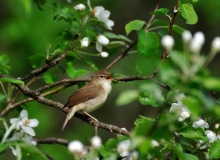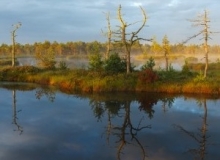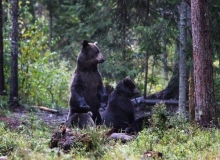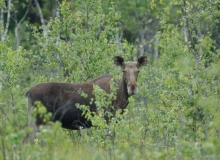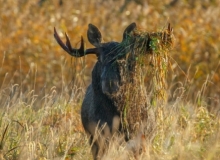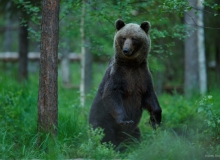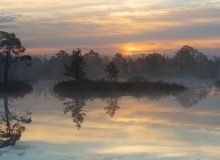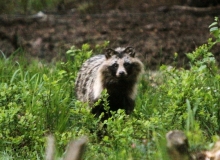The small northern European country of Estonia has rapidly become a popular bird-watching destination. Although spring is a favourite time for birding (if the aim is to see as many bird species as possible), many birdwatchers leave the country in mid-May having missed the late eastern warblers or not having heard a lovely greeting of Scarlet Rosefinch. If the spring is cold, birds in migration stress may stay quiet for a while and become more active in summer. Suitable for birdwatchers with partners.
Time: Mid-June Group: 6-16 pax
In early June the warblers and finches are present and still singing. The spring rush is over and the fortissimo of the bird-choir is gradually replaced by mezzoforte, then lowers to the mezzo-piano of the midsummer. It’s a great time for enjoying individual talents like Marsh and Blyth’s Reed Warbler.
Raptors and Black Storks have chicks to feed and that brings them to the high skies and open spaces. Ural Owl fledglings demand heaps of bushmeat and their parents can take only short siestas in mid-day.
To see or hear many of these birds, one has to take time. Why not enjoy the lush floral beauty of Estonian wooded meadows, alvars or even colourful fallows, to get familiar with abundant Estonian orchids, butterflies and dragonflies or enjoy outdoor cooking, watching the hustling of the hawk-moths on the flowers of honeysuckle while waiting for a Ural Owl to appear? Our guides can help you to notice and identify these while still focusing primarily on birds. We expect to see at least 155 species during this trip.
On evening bird trips encounters with Elks are not rare. Many other mammals, Beaver, Fox or Roe Deer, are quite common and usually seen. We’ll visit the largest island in Estonia – Saaremaa, one of the country’s sweetest nature tourist destinations. Besides being a superb place for birdwatching, it offers also outstanding scenic beauty – be it a meadow covered with a thick purple and golden carpet of a Cow-wheat (Melampyrum nemorosum), a rye-field gleaming with vibrant colours of poppies and cornflowers, herds of rustic Estonian horses keeping the coastal meadow habitats open for Black-tailed Godwits and Baltic Dunlin, sculptural juniper groves with Barred Warblers and Red-backed Shrikes, idyllic fishermen villages with stone fences and reed roofs, or a huge, storied meteorite crater at Kaali.
White-tailed Eagle, grouse, owls, woodpeckers, Thrush Nightingale, Savi’s Warbler, River Warbler, Common Rosefinch and other eastern migrants. We will make a special trip to find Booted Warbler – an eastern migrant which has started to settle in Estonia. Estonia is also a good place for watching mammals – it has healthy populations of Beaver, Brown Bear, Wolf, Lynch, Otter and Moose.
Book a tour with us: info@natourest.ee or by phone: +372 5622 5943
Day 1: Arrival (Tallinn)
We will start our trip in Tallinn, and head to Tartu Viewing the Great Snipe lek – the male mating dance – in late evening is the first highlight of the trip. There are also chances to see Ural Owl and Nightjar.
Day 2: Tartu, Alam-Pedja Nature Reserve
Alam-Pedja reserve is a vast wilderness area northwest of Tartu. A breeding area of many raptors, Black Storks, Capercaillie, different woodpecker species and waterfowl, it has much to offer. The sight of the Spotted Eagle, breeding here together with many pairs of Lesser Spotted Eagles, is quite possible.
Day 3: Tartu, Aardla polder and Ilmatsalu fish ponds
At Aardla polder we’ll check the marshes for waterfowl like the Black Terns, Little Gulls and Red-Breasted Grebes. Gorgeous Citrine Wagtails should be swinging on the flower heads of the violet Siberian Flags. Penduline Tits, Common Rosefinch, River Warbler and Corncrake and Savi’s Warbler thrive here. Ilmatsalu fishponds are the breeding grounds for Whooper Swans, ducks, grebes and Great Bitterns. Likely sightings are Water Rails, Moorhens and Spotted and Common Crakes. Sometimes the Little Crake can also be heard. Lunch in Tartu is likely to be accompanied with the singing of Greenish Warbles. In the evening we’ll visit a cottage in the woods, cook dinner and wait for the Ural Owl. While enjoying our chili con carne or vegetarian chili, we will have an opportunity to observe hawk-moths swarming around the flowers of the sweet-scented honeysuckle.
Day 4: South-Eastern Estonia
We’ll head for South-Eastern Estonia, close to the Russian border to check Veretinä village for the Booted Warbler. Later we’ll visit Värska polder, Värska park for Medium-spotted Woodpecker and Piusa river (Clouded Apollo, Kingfisher, Sandstone Rocks).
Day 5: Häädemeeste Soometsa-Rannametsa nature reserve, Pikla fish ponds
We leave Tartu and drive to an area close to Latvian border which offers us both coastal and forest bird species. The combined Soometsa- Rannametsa nature reserves, which are a consolidation of several smaller protected areas, are rich with both coniferous forests, bogs, heathland and wetland habitats and is host to Black Storks, Capercaillies, Lesser-spotted Eagles and many other forest birds. At Pikla fish ponds we should see more waterfowl, raptors and reedbed species such as Savi’s, Great Reed Warblers and Bitterns. The region is also a sanctuary for many rare and endangered plants.
Day 6: Nigula bog, Puhtu- Laelatu- Saaremaa
Early in the morning, we’ll visit Nigula Nature reserve – a beautiful bog with mineral islands covered with old-growth forests and bog pools. It is an excellent place for many waders, raptors, grouses and Black Stork. In the afternoon we’ll take a look at a species-rich wooded meadow in Laelatu and the broad-leaved forest of Puhtu to see Red-breasted Flycatcher among many other birds. Later in the afternoon, we’ll board a ferry for Saaremaa.
Day 7: Saaremaa (Sõrve-Viidumäe, Loode)
We’ll spend this day in the westernmost part of Saaremaa known for scenic views, orchids and other rare plants and encounters with interesting birds. Sõrve peninsula acts as a bottleneck for birds in migration time and hosts an almost permanently manned bird-station. Information about the birds encountered is generously shared – this peninsula always holds some pleasant surprise. One recent trend is the increasing number of Collared Flycatchers in Western Saaremaa. Viidumäe has great botanical values (relics from different climate periods and even an endemic plant species – Saaremaa Rattler) as well as remarkable bird fauna. Besides several woodpecker and owl species, it also hosts Hazel Grouses, Nutcrackers, etc. Loode Oak Grove is also great both for birdwatchers and plant enthusiasts: when chasing a Wryneck or Barred Warbler, one has to take care not to step on a Lady Slipper, seen here earlier in the season in thousands. (Unfortunately, many are gone by mid-June. You’ll want to come back in Spring!)
Day 8: Saaremaa (Tagamõisa-Harilaid)
The Tagamõisa wooded meadow is interesting for its wide diversity of plants, but it is also believed that the ratio between the breeding pairs of Collared and Pied Flycatchers in this area is about 1/20. Close to Tagamõisa is Harilaid – one of the youngest and most scenic peninsulas in Estonia – offering both botanical and ornithological surprises, perhaps a Tawny Pipit.
Day 9: Kaali, Laidevahe, Muhu
The meteorite crater field in Kaali, Saaremaa is the rarest natural phenomenon in Estonia, and is the most impressive crater field of all Eurasia. Stories about its origin and possible sacred ceremonies abound. We will also visit Laidevahe Nature Reserve – a diverse RAMSAR- listed wetlands filled with inlets, coastal lagoons, reed-beds and coastal and wooded meadows. Ospreys, White-Tailed and Golden Eagles are a common sight. Sandwich, Caspian and Little Terns, Red-Necked and Slavonian Grebes can often be seen. Later in afternoon, we’ll take the ferry back to the mainland. Even the weeds on the fields can be very colourful. The poppies and Vipers Bugloss are there to be enjoyed; the Ortolan Bunting was spotted in 2008.
Day 10: Matsalu National Park
A day at Estonia’s most famous wetland complex, with vast spaces of coastal and alluvial (and some wooded) meadows and reed-beds, will be one to remember.
Day 11: Silma, Haapsalu, Marimetsa
Silma Nature Reserve near Haapsalu consists of shallow sea, coastal lagoons, reed-bed, meadows and other coastal habitats. To watch: various Grebes, Water Rails, Bitterns, Bearded and Penduline Tit. Little Black-headed Gulls, Black Terns are numerous in this reserve. Marimetsa peat bog can offer us a sight of Black Grouse, Whimbrel, Golden Plover, Crested Tit or Great Grey Shrike. We’ll head back to Tallinn in the evening for dinner in a nice restaurant. Day 12: Departure from Tallinn
Day 12: Departure from Tallinn
Book a tour with us: info@natourest.ee or by phone: +372 5622 5943
Price for guided groups
Price includes 12 days local guide service; 11 nights in local guesthouses and hotels in double room; 11 dinners, breakfasts and lunch packages, local transport, ferry ticket to Saaremaa.
- 2 people: 2670 eur/ per person
- 4 people: 1715 eur/ per person
- 6 people: 1375 eur/ per person
- 8 person: 1210 eur/ per person
Season: end of May – June.
Book a tour with us: info@natourest.ee or by phone: +3725622 5943







